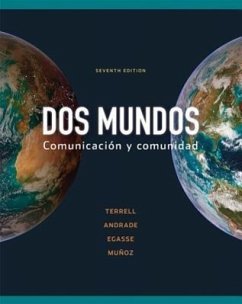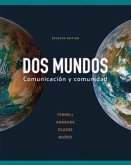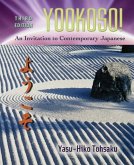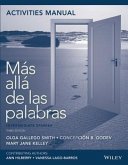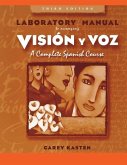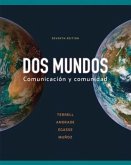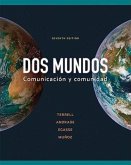Tracy D Terrell, Magdalena Andrade, Jeanne Egasse, Elías Miguel Muñoz
Workbook/Lab Manual Part A to Accompany DOS Mundos
Tracy D Terrell, Magdalena Andrade, Jeanne Egasse, Elías Miguel Muñoz
Workbook/Lab Manual Part A to Accompany DOS Mundos
- Broschiertes Buch
- Merkliste
- Auf die Merkliste
- Bewerten Bewerten
- Teilen
- Produkt teilen
- Produkterinnerung
- Produkterinnerung
The Cuaderno de actividades is intended for use primarily outside the classroom. This combined workbook/laboratory manual features Actividades escritas, Actividades auditivas, Resumen cultural, Pronunciacion y ortografia, Videoteca, and Lecturas. The Preface in the Cuaderno de actividades provides a detailed description of all sections and types of activities. This version of the Cuaderno covers the first half the book, Paso A-Capitulo 7.
Andere Kunden interessierten sich auch für
![Workbook/Lab Manual Part B to Accompany DOS Mundos Workbook/Lab Manual Part B to Accompany DOS Mundos]() Tracy D TerrellWorkbook/Lab Manual Part B to Accompany DOS Mundos165,99 €
Tracy D TerrellWorkbook/Lab Manual Part B to Accompany DOS Mundos165,99 €![Workbook/Lab Manual to Accompany Yookoso!: Continuing with Contemporary Japanese Workbook/Lab Manual to Accompany Yookoso!: Continuing with Contemporary Japanese]() Yasu-Hiko TohsakuWorkbook/Lab Manual to Accompany Yookoso!: Continuing with Contemporary Japanese176,99 €
Yasu-Hiko TohsakuWorkbook/Lab Manual to Accompany Yookoso!: Continuing with Contemporary Japanese176,99 €![Activities Manual to Accompany Mas Alla de Las Palabras: Intermediate Spanish, 3e with Lab Audio Registration Card Activities Manual to Accompany Mas Alla de Las Palabras: Intermediate Spanish, 3e with Lab Audio Registration Card]() Olga Gallego SmithActivities Manual to Accompany Mas Alla de Las Palabras: Intermediate Spanish, 3e with Lab Audio Registration Card149,99 €
Olga Gallego SmithActivities Manual to Accompany Mas Alla de Las Palabras: Intermediate Spanish, 3e with Lab Audio Registration Card149,99 €![Lab Manual to Accompany Vision Y Voz: Introductory Spanish, 3e Lab Manual to Accompany Vision Y Voz: Introductory Spanish, 3e]() Vicki GallowayLab Manual to Accompany Vision Y Voz: Introductory Spanish, 3e106,99 €
Vicki GallowayLab Manual to Accompany Vision Y Voz: Introductory Spanish, 3e106,99 €![Dos Mundos Dos Mundos]() Tracy D TerrellDos Mundos220,99 €
Tracy D TerrellDos Mundos220,99 €![DOS Mundos DOS Mundos]() Tracy D TerrellDOS Mundos296,99 €
Tracy D TerrellDOS Mundos296,99 €![Workbook/Laboratory Manual to Accompany Conéctate Workbook/Laboratory Manual to Accompany Conéctate]() Grant GoodallWorkbook/Laboratory Manual to Accompany Conéctate237,99 €
Grant GoodallWorkbook/Laboratory Manual to Accompany Conéctate237,99 €-
-
-
The Cuaderno de actividades is intended for use primarily outside the classroom. This combined workbook/laboratory manual features Actividades escritas, Actividades auditivas, Resumen cultural, Pronunciacion y ortografia, Videoteca, and Lecturas. The Preface in the Cuaderno de actividades provides a detailed description of all sections and types of activities. This version of the Cuaderno covers the first half the book, Paso A-Capitulo 7.
Hinweis: Dieser Artikel kann nur an eine deutsche Lieferadresse ausgeliefert werden.
Hinweis: Dieser Artikel kann nur an eine deutsche Lieferadresse ausgeliefert werden.
Produktdetails
- Produktdetails
- Verlag: McGraw Hill LLC
- 7th edition
- Seitenzahl: 224
- Erscheinungstermin: 1. Mai 2009
- Englisch
- Abmessung: 274mm x 211mm x 13mm
- Gewicht: 476g
- ISBN-13: 9780077304737
- ISBN-10: 007730473X
- Artikelnr.: 26100346
- Herstellerkennzeichnung
- Libri GmbH
- Europaallee 1
- 36244 Bad Hersfeld
- 06621 890
- Verlag: McGraw Hill LLC
- 7th edition
- Seitenzahl: 224
- Erscheinungstermin: 1. Mai 2009
- Englisch
- Abmessung: 274mm x 211mm x 13mm
- Gewicht: 476g
- ISBN-13: 9780077304737
- ISBN-10: 007730473X
- Artikelnr.: 26100346
- Herstellerkennzeichnung
- Libri GmbH
- Europaallee 1
- 36244 Bad Hersfeld
- 06621 890
Tracy D. Terrell (late) received his Ph.D. in Spanish Linguistics from the University of Texas at Austin and published extensively in the area of Spanish dialectology. Professor Terrell's publications on second-language acquisition are widely known in the United States and abroad.
(Note: The preliminary chapters (Paso A-C) and Capítulo 1 of this Table of Contents provide a comprehensive listing of contents for those chapters, as representative of the other chapters. Capítulo 2-15 provides only the vocabulary topics and grammatical structures.) The following lists the Enlace readings found in each chapter:Capítulo 1 Enlace a la música . CubaCapítulo 2 Enlace a la música . La música andina Capítulo 3 Enlace al cine . México y España Capítulo 4 Enlace a la literatura . "Versos sencillos" José MartíCapítulo 5 Enlace a la música . El rock en españolCapítulo 6 Enlace a la literatura . "Cuadrados y ángulos" Alfonsina Storni Capítulo 7 Enlace a la literatura . "Cuando salimos de El Salvador" Jorge ArguetaCapítulo 8 Enlace a la literatura . "Jitomates risueños" Francisco X. AlarcónCapítulo 9 Enlace a la música . La música infantilCapítulo 10 Enlace a la literatura . "Dos cuerpos" Octavio PazCapítulo 11 Enlace a la música . La danza negra en PerúCapítulo 12 Enlace al cine . Argentina y Chile Capítulo 13 Enlace a la literatura . "Nada más" María Elena WalshCapítulo 14 Enlace a la literatura . "Kinsey Report No.6" Rosario CastellanosCapítulo 15 Enlace a la literatura . "La noche buena" Tomás Rivera Paso A La clase y los estudiantes Actividades de comunicación Los nombres de los compañeros de clase
Quién es? Los colores y la ropa Los números (0-39) Los saludos Gramática A.1 Naming and Describing: The Verbs llamar and llevar A.2 Spelling: The Spanish Alphabet A.3 Identifying People and Things: Subject Pronouns and the Verb ser A.4 Identifying People and Things: Gender A.5 Responding to Instructions:Commands Paso B Las descripciones Actividades de comunicación Hablando con otros Las cosas en el salón de clase Los números (40-69) El cuerpo humano La descripción de las personas Gramática B.1 Addressing Others: Informal and Polite you (tú/usted) B.2 Expressing Existence: hay B.3 Describing People and Things:Negation B.4 Describing People and Things: Plural Forms B.5 Describing People and Things: Adjective-Noun Agreementand Placement Paso C Mi familia y mis amigos Actividades de comunicación La familia
Qué tenemos? Los números (10-100) y la edad Los idiomas y las nacionalidades Gramática C.1 Expressing Possession: The Verbs tener and ser de (l) C.2 Expressing Possession: Possessive Adjectives C.3 Expressing Age: The Verb tener C.4 Describing People: Adjectives of Nationality C.5 Talking about Habitual Actions: Present Tense of Regular -ar Verbs Capítulo 1 Los datos personales y las actividadesActividades de comunicación y lecturas Las fechas y los cumpleaños Datos personales: El teléfono y la dirección Ventanas culturales . Nuestra comunidad: Rigoberta Menchú Enlace a la música . Cuba La hora Las actividades favoritas y los deportes Ventanas al pasado . Diego Rivera y Frida Kahlo En resumen Lectura: La pasión por los deportes Gramática 1.1 Counting: Numbers 100-1000 and Dates 1.2 Talking about Habitual Actions: Present Tense of -er and -ir Verbs 1.3 Asking Questions: Question Formation 1.4 Telling Time: Hours and Minutes 1.5 Expressing Likes and Dislikes: gustar + Infinitive Capítulo 2 Mis planes y preferencias Actividades de comunicación Los planes Las clases Las preferencias y los deseos El tiempo Gramática 2.1 Expressing Future Plans: ir + a + Infinitive 2.2 Sequencing: Ordinal Adjectives 2.3 Stating Preferences and Desires: preferir and querer + Infinitive 2.4 Describing the Weather: Common Expressions 2.5 Pointing Out People and Objects: Demonstrative Adjectives Capítulo 3 Los lugares y las actividades Actividades de comunicación Las actividades diarias Las tres comidas Los lugares
De dónde es usted? Gramática 3.1 Talking about Habitual Actions: Present Tense of Regular Verbs 3.2 Using Irregular Verbs: haver, salir, jugar 3.3 Referring to Objects Already Mentioned: Direct Object Pronouns lo, la, los, and las 3.4 Asking and Answering Questions 3.5 Talking About Location and Origin: estar + en, ir + al / a la and ser de Capítulo 4 La vida diaria y los días feriadosActividades de comunicación Los dias feriados y las celebraciones La rutina diaria Los estados físicos y anímicos Gramática 4.1 Discussing Habitual Actions: Verbs with Stem-Vowel Changes (ie, ue) in the Present Tense 4.2 Discussing Habitual Actions: Irregular Verbs 4.3 Describing Daily Routine: Reflexives 4.4 Ordering Events: Infinitives after Prepositions 4.5 Describing States: estar + Adjective and tener + Noun Capítulo 5 Las clases y el trabajo Actividades de comunicación Las actividades de la clase de español Las habilidades Las carreras y las actividades del trabajo Las actividades futuras Gramática 5.1 Indicating to Whom Something is Said: Indirect Object Pronouns with Verbs of Informing 5.2 Expressing Abilities: saber and poder + Infinitive 5.3 Referring to Actions in Progress: Present Progressive 5.4 Expressing Obligation and Duty: tener que, deber, necesitar, hay que, es necesario 5.5 Expressing Plans and Desires: pensar, quisiera, me gustaría, tener ganas de Capítulo 6 La residencia Actividades de comunicación El vecindario y la casa Las actividades en casa Las actividades con los amigos Las presentaciones Gramática 6.1 Making Comparisons of Inequality: más/menos 6.2 Making Comparisons of Equality: tan/tanto 6.3 Talking about Past Actions: Preterite Tense of Regular Verbs (Part 1) 6.4 Knowing People, Places, and Facts: conocer and saber 6.5 Referring to People Already Mentioned: Personal Direct Object Pronouns Capítulo 7 Hablando del pasado Actividades de comunicación Mis experiencias Las experiencias con los demás Hablando del pasado Gramática 7.1 Talking About Past Actions:Preterite Tense of RegularVerbs (Part 2) 7.2 Relating Past Events (Part 1): Verbs with Irregular Preterite Forms 7.3 More About Relating Past Events (Part 2): Stem-Changing Verbs in the Preterite 7.4 Reporting the Past: Indirect Object Pronouns with decir 7.5 Expressing ago: hacer + Time Capítulo 8 La comida Actividades de comunicación Las comidas, las bebidas y la nutrición La compra y la preparación
de la comida Los restaurantes Gramática 8.1 Referring to Objects Already Mentioned: Impersonal Direct Object Pronouns lo, la, los, and las 8.2 More about Expressing Likes: The Verbs gustar and encantar 8.3 Making Negative Statements and Questions: No, never 8.4 Expressing one or you: The Impersonal se 8.5 Using Stem-Changing Verbs like pedir and servir: Present Tense and Preterite Forms Capítulo 9 La niñez y la juventud Actividades de comunicación La familia y los parientes La niñez La juventud Gramática 9.1 Describing Family Relationships: The Reciprocal Reflexive Verbs parecerse and llevarse bien 9.2 Expressing for, from, to whom: Prepositions + Pronouns 9.3 Saying What You Used to Do: The Imperfect Tense 9.4 Describing the Past: The Imperfect and Preterite of "State" Verbs 9.5 Saying What You Were Going to Do: The Imperfect Tense of ir + a + Infinitive Capítulo 10 Nuestro planeta Actividades de comunicación La geografía y el clima Los medios de transporte La ecología y el medio ambiente Gramática 10.1 Saying What You Have Done: The Present Perfect 10.2 Exclamations with ¡Qué... !, ¡Cuánto/a/os/as... ! 10.3 Expressing by, through, Destination and Time (Part 1): por and para 10.4 Describing Actions: Adverbs 10.5 Expressing Reactions: More Verbs like gustar Capítulo 11 De viaje Actividades de comunicación Los viajes en automóvil En busca de sitios Los planes de viaje Los sitios turísticos Gramática 11.1 Giving Instructions: Polite Commands 11.2 Softening Commands (Part 1): The Present Subjunctive following querer 11.3 Expressing Indefinite Future and Present Subjunctive of Irregular Verbs 11.4 Talking About Past Actions in Progress: Imperfect Progressive 11.5 Saying What Was Happening: The Imperfect in Contrast to the Preterite Capítulo 12 La salud y las emergencias Actividades de comunicación El cuerpo humano y la salud Las enfermedades y su tratamiento Las visitas al médico, a la farmacia y al hospital Los accidentes y las emergencias Gramática 12.1 Expressing Existence: haber 12.2 Expressing Changes in States: Become, get 12.3 Making Requests: Indirect Object Pronouns with Commands and the Present Subjunctive 12.4 Adverbs Relating Unplanned Occurrences: se 12.5 Narrating Past Experiences: Present Perfect, Imperfect, and Preterite Capítulo 13 De compras Actividades de comunicación Los productos y los materiales Los precios Comprando ropa Las compras y el regateo Gramática 13.1 Describing People and Things: Adjectives Used as Nouns 13.2 Indicating Which Ones(s): Demonstrative Pronouns 13.3 Talking about Price, Beneficiary, and Purpose: por and para (Part 2) 13.4 Exchanging Items: Indirect Object Pronouns 13.5 Referring to People and Things Already Mentioned: Using Indirect and Direct Object Pronouns Together Capítulo 14 La familia y los consejos Actividades de comunicación La familia, las amistades y el matrimonio Las instrucciones y los mandatos Las órdenes, los consejos y las sugerencias La crianza y el comportamiento Gramática 14.1 Expressing each other: Reciprocal Nouns 14.2 Describing: ser and estar 14.3 Giving Direct Commands: Polite and Informal 14.4 Using Softened Commands: The Subjunctive Mood 14.5 Saying Let/Have Someone Else Do It!: ¡Que + Subjunctive! Capítulo 15 El porvenir Actividades de comunicación El futuro y las metas personales Cuestiones sociales El futuro y la tecnología: Posibilidades y consecuencias Gramática 15.1 Talking about the Future: The Future Tense 15.2 Talking about When: The Subjunctive in Time Clauses 15.3 Adding Details and Expressing Why and How: More Uses of the Subjunctive 15.4 Expressing Opinions and Reactions: Indicative and Subjunctive 15.5 Hypothetical Reactions: The Conditional 15.6 If Clauses and the Past Subjunctive
Quién es? Los colores y la ropa Los números (0-39) Los saludos Gramática A.1 Naming and Describing: The Verbs llamar and llevar A.2 Spelling: The Spanish Alphabet A.3 Identifying People and Things: Subject Pronouns and the Verb ser A.4 Identifying People and Things: Gender A.5 Responding to Instructions:Commands Paso B Las descripciones Actividades de comunicación Hablando con otros Las cosas en el salón de clase Los números (40-69) El cuerpo humano La descripción de las personas Gramática B.1 Addressing Others: Informal and Polite you (tú/usted) B.2 Expressing Existence: hay B.3 Describing People and Things:Negation B.4 Describing People and Things: Plural Forms B.5 Describing People and Things: Adjective-Noun Agreementand Placement Paso C Mi familia y mis amigos Actividades de comunicación La familia
Qué tenemos? Los números (10-100) y la edad Los idiomas y las nacionalidades Gramática C.1 Expressing Possession: The Verbs tener and ser de (l) C.2 Expressing Possession: Possessive Adjectives C.3 Expressing Age: The Verb tener C.4 Describing People: Adjectives of Nationality C.5 Talking about Habitual Actions: Present Tense of Regular -ar Verbs Capítulo 1 Los datos personales y las actividadesActividades de comunicación y lecturas Las fechas y los cumpleaños Datos personales: El teléfono y la dirección Ventanas culturales . Nuestra comunidad: Rigoberta Menchú Enlace a la música . Cuba La hora Las actividades favoritas y los deportes Ventanas al pasado . Diego Rivera y Frida Kahlo En resumen Lectura: La pasión por los deportes Gramática 1.1 Counting: Numbers 100-1000 and Dates 1.2 Talking about Habitual Actions: Present Tense of -er and -ir Verbs 1.3 Asking Questions: Question Formation 1.4 Telling Time: Hours and Minutes 1.5 Expressing Likes and Dislikes: gustar + Infinitive Capítulo 2 Mis planes y preferencias Actividades de comunicación Los planes Las clases Las preferencias y los deseos El tiempo Gramática 2.1 Expressing Future Plans: ir + a + Infinitive 2.2 Sequencing: Ordinal Adjectives 2.3 Stating Preferences and Desires: preferir and querer + Infinitive 2.4 Describing the Weather: Common Expressions 2.5 Pointing Out People and Objects: Demonstrative Adjectives Capítulo 3 Los lugares y las actividades Actividades de comunicación Las actividades diarias Las tres comidas Los lugares
De dónde es usted? Gramática 3.1 Talking about Habitual Actions: Present Tense of Regular Verbs 3.2 Using Irregular Verbs: haver, salir, jugar 3.3 Referring to Objects Already Mentioned: Direct Object Pronouns lo, la, los, and las 3.4 Asking and Answering Questions 3.5 Talking About Location and Origin: estar + en, ir + al / a la and ser de Capítulo 4 La vida diaria y los días feriadosActividades de comunicación Los dias feriados y las celebraciones La rutina diaria Los estados físicos y anímicos Gramática 4.1 Discussing Habitual Actions: Verbs with Stem-Vowel Changes (ie, ue) in the Present Tense 4.2 Discussing Habitual Actions: Irregular Verbs 4.3 Describing Daily Routine: Reflexives 4.4 Ordering Events: Infinitives after Prepositions 4.5 Describing States: estar + Adjective and tener + Noun Capítulo 5 Las clases y el trabajo Actividades de comunicación Las actividades de la clase de español Las habilidades Las carreras y las actividades del trabajo Las actividades futuras Gramática 5.1 Indicating to Whom Something is Said: Indirect Object Pronouns with Verbs of Informing 5.2 Expressing Abilities: saber and poder + Infinitive 5.3 Referring to Actions in Progress: Present Progressive 5.4 Expressing Obligation and Duty: tener que, deber, necesitar, hay que, es necesario 5.5 Expressing Plans and Desires: pensar, quisiera, me gustaría, tener ganas de Capítulo 6 La residencia Actividades de comunicación El vecindario y la casa Las actividades en casa Las actividades con los amigos Las presentaciones Gramática 6.1 Making Comparisons of Inequality: más/menos 6.2 Making Comparisons of Equality: tan/tanto 6.3 Talking about Past Actions: Preterite Tense of Regular Verbs (Part 1) 6.4 Knowing People, Places, and Facts: conocer and saber 6.5 Referring to People Already Mentioned: Personal Direct Object Pronouns Capítulo 7 Hablando del pasado Actividades de comunicación Mis experiencias Las experiencias con los demás Hablando del pasado Gramática 7.1 Talking About Past Actions:Preterite Tense of RegularVerbs (Part 2) 7.2 Relating Past Events (Part 1): Verbs with Irregular Preterite Forms 7.3 More About Relating Past Events (Part 2): Stem-Changing Verbs in the Preterite 7.4 Reporting the Past: Indirect Object Pronouns with decir 7.5 Expressing ago: hacer + Time Capítulo 8 La comida Actividades de comunicación Las comidas, las bebidas y la nutrición La compra y la preparación
de la comida Los restaurantes Gramática 8.1 Referring to Objects Already Mentioned: Impersonal Direct Object Pronouns lo, la, los, and las 8.2 More about Expressing Likes: The Verbs gustar and encantar 8.3 Making Negative Statements and Questions: No, never 8.4 Expressing one or you: The Impersonal se 8.5 Using Stem-Changing Verbs like pedir and servir: Present Tense and Preterite Forms Capítulo 9 La niñez y la juventud Actividades de comunicación La familia y los parientes La niñez La juventud Gramática 9.1 Describing Family Relationships: The Reciprocal Reflexive Verbs parecerse and llevarse bien 9.2 Expressing for, from, to whom: Prepositions + Pronouns 9.3 Saying What You Used to Do: The Imperfect Tense 9.4 Describing the Past: The Imperfect and Preterite of "State" Verbs 9.5 Saying What You Were Going to Do: The Imperfect Tense of ir + a + Infinitive Capítulo 10 Nuestro planeta Actividades de comunicación La geografía y el clima Los medios de transporte La ecología y el medio ambiente Gramática 10.1 Saying What You Have Done: The Present Perfect 10.2 Exclamations with ¡Qué... !, ¡Cuánto/a/os/as... ! 10.3 Expressing by, through, Destination and Time (Part 1): por and para 10.4 Describing Actions: Adverbs 10.5 Expressing Reactions: More Verbs like gustar Capítulo 11 De viaje Actividades de comunicación Los viajes en automóvil En busca de sitios Los planes de viaje Los sitios turísticos Gramática 11.1 Giving Instructions: Polite Commands 11.2 Softening Commands (Part 1): The Present Subjunctive following querer 11.3 Expressing Indefinite Future and Present Subjunctive of Irregular Verbs 11.4 Talking About Past Actions in Progress: Imperfect Progressive 11.5 Saying What Was Happening: The Imperfect in Contrast to the Preterite Capítulo 12 La salud y las emergencias Actividades de comunicación El cuerpo humano y la salud Las enfermedades y su tratamiento Las visitas al médico, a la farmacia y al hospital Los accidentes y las emergencias Gramática 12.1 Expressing Existence: haber 12.2 Expressing Changes in States: Become, get 12.3 Making Requests: Indirect Object Pronouns with Commands and the Present Subjunctive 12.4 Adverbs Relating Unplanned Occurrences: se 12.5 Narrating Past Experiences: Present Perfect, Imperfect, and Preterite Capítulo 13 De compras Actividades de comunicación Los productos y los materiales Los precios Comprando ropa Las compras y el regateo Gramática 13.1 Describing People and Things: Adjectives Used as Nouns 13.2 Indicating Which Ones(s): Demonstrative Pronouns 13.3 Talking about Price, Beneficiary, and Purpose: por and para (Part 2) 13.4 Exchanging Items: Indirect Object Pronouns 13.5 Referring to People and Things Already Mentioned: Using Indirect and Direct Object Pronouns Together Capítulo 14 La familia y los consejos Actividades de comunicación La familia, las amistades y el matrimonio Las instrucciones y los mandatos Las órdenes, los consejos y las sugerencias La crianza y el comportamiento Gramática 14.1 Expressing each other: Reciprocal Nouns 14.2 Describing: ser and estar 14.3 Giving Direct Commands: Polite and Informal 14.4 Using Softened Commands: The Subjunctive Mood 14.5 Saying Let/Have Someone Else Do It!: ¡Que + Subjunctive! Capítulo 15 El porvenir Actividades de comunicación El futuro y las metas personales Cuestiones sociales El futuro y la tecnología: Posibilidades y consecuencias Gramática 15.1 Talking about the Future: The Future Tense 15.2 Talking about When: The Subjunctive in Time Clauses 15.3 Adding Details and Expressing Why and How: More Uses of the Subjunctive 15.4 Expressing Opinions and Reactions: Indicative and Subjunctive 15.5 Hypothetical Reactions: The Conditional 15.6 If Clauses and the Past Subjunctive
(Note: The preliminary chapters (Paso A-C) and Capítulo 1 of this Table of Contents provide a comprehensive listing of contents for those chapters, as representative of the other chapters. Capítulo 2-15 provides only the vocabulary topics and grammatical structures.) The following lists the Enlace readings found in each chapter:Capítulo 1 Enlace a la música . CubaCapítulo 2 Enlace a la música . La música andina Capítulo 3 Enlace al cine . México y España Capítulo 4 Enlace a la literatura . "Versos sencillos" José MartíCapítulo 5 Enlace a la música . El rock en españolCapítulo 6 Enlace a la literatura . "Cuadrados y ángulos" Alfonsina Storni Capítulo 7 Enlace a la literatura . "Cuando salimos de El Salvador" Jorge ArguetaCapítulo 8 Enlace a la literatura . "Jitomates risueños" Francisco X. AlarcónCapítulo 9 Enlace a la música . La música infantilCapítulo 10 Enlace a la literatura . "Dos cuerpos" Octavio PazCapítulo 11 Enlace a la música . La danza negra en PerúCapítulo 12 Enlace al cine . Argentina y Chile Capítulo 13 Enlace a la literatura . "Nada más" María Elena WalshCapítulo 14 Enlace a la literatura . "Kinsey Report No.6" Rosario CastellanosCapítulo 15 Enlace a la literatura . "La noche buena" Tomás Rivera Paso A La clase y los estudiantes Actividades de comunicación Los nombres de los compañeros de clase
Quién es? Los colores y la ropa Los números (0-39) Los saludos Gramática A.1 Naming and Describing: The Verbs llamar and llevar A.2 Spelling: The Spanish Alphabet A.3 Identifying People and Things: Subject Pronouns and the Verb ser A.4 Identifying People and Things: Gender A.5 Responding to Instructions:Commands Paso B Las descripciones Actividades de comunicación Hablando con otros Las cosas en el salón de clase Los números (40-69) El cuerpo humano La descripción de las personas Gramática B.1 Addressing Others: Informal and Polite you (tú/usted) B.2 Expressing Existence: hay B.3 Describing People and Things:Negation B.4 Describing People and Things: Plural Forms B.5 Describing People and Things: Adjective-Noun Agreementand Placement Paso C Mi familia y mis amigos Actividades de comunicación La familia
Qué tenemos? Los números (10-100) y la edad Los idiomas y las nacionalidades Gramática C.1 Expressing Possession: The Verbs tener and ser de (l) C.2 Expressing Possession: Possessive Adjectives C.3 Expressing Age: The Verb tener C.4 Describing People: Adjectives of Nationality C.5 Talking about Habitual Actions: Present Tense of Regular -ar Verbs Capítulo 1 Los datos personales y las actividadesActividades de comunicación y lecturas Las fechas y los cumpleaños Datos personales: El teléfono y la dirección Ventanas culturales . Nuestra comunidad: Rigoberta Menchú Enlace a la música . Cuba La hora Las actividades favoritas y los deportes Ventanas al pasado . Diego Rivera y Frida Kahlo En resumen Lectura: La pasión por los deportes Gramática 1.1 Counting: Numbers 100-1000 and Dates 1.2 Talking about Habitual Actions: Present Tense of -er and -ir Verbs 1.3 Asking Questions: Question Formation 1.4 Telling Time: Hours and Minutes 1.5 Expressing Likes and Dislikes: gustar + Infinitive Capítulo 2 Mis planes y preferencias Actividades de comunicación Los planes Las clases Las preferencias y los deseos El tiempo Gramática 2.1 Expressing Future Plans: ir + a + Infinitive 2.2 Sequencing: Ordinal Adjectives 2.3 Stating Preferences and Desires: preferir and querer + Infinitive 2.4 Describing the Weather: Common Expressions 2.5 Pointing Out People and Objects: Demonstrative Adjectives Capítulo 3 Los lugares y las actividades Actividades de comunicación Las actividades diarias Las tres comidas Los lugares
De dónde es usted? Gramática 3.1 Talking about Habitual Actions: Present Tense of Regular Verbs 3.2 Using Irregular Verbs: haver, salir, jugar 3.3 Referring to Objects Already Mentioned: Direct Object Pronouns lo, la, los, and las 3.4 Asking and Answering Questions 3.5 Talking About Location and Origin: estar + en, ir + al / a la and ser de Capítulo 4 La vida diaria y los días feriadosActividades de comunicación Los dias feriados y las celebraciones La rutina diaria Los estados físicos y anímicos Gramática 4.1 Discussing Habitual Actions: Verbs with Stem-Vowel Changes (ie, ue) in the Present Tense 4.2 Discussing Habitual Actions: Irregular Verbs 4.3 Describing Daily Routine: Reflexives 4.4 Ordering Events: Infinitives after Prepositions 4.5 Describing States: estar + Adjective and tener + Noun Capítulo 5 Las clases y el trabajo Actividades de comunicación Las actividades de la clase de español Las habilidades Las carreras y las actividades del trabajo Las actividades futuras Gramática 5.1 Indicating to Whom Something is Said: Indirect Object Pronouns with Verbs of Informing 5.2 Expressing Abilities: saber and poder + Infinitive 5.3 Referring to Actions in Progress: Present Progressive 5.4 Expressing Obligation and Duty: tener que, deber, necesitar, hay que, es necesario 5.5 Expressing Plans and Desires: pensar, quisiera, me gustaría, tener ganas de Capítulo 6 La residencia Actividades de comunicación El vecindario y la casa Las actividades en casa Las actividades con los amigos Las presentaciones Gramática 6.1 Making Comparisons of Inequality: más/menos 6.2 Making Comparisons of Equality: tan/tanto 6.3 Talking about Past Actions: Preterite Tense of Regular Verbs (Part 1) 6.4 Knowing People, Places, and Facts: conocer and saber 6.5 Referring to People Already Mentioned: Personal Direct Object Pronouns Capítulo 7 Hablando del pasado Actividades de comunicación Mis experiencias Las experiencias con los demás Hablando del pasado Gramática 7.1 Talking About Past Actions:Preterite Tense of RegularVerbs (Part 2) 7.2 Relating Past Events (Part 1): Verbs with Irregular Preterite Forms 7.3 More About Relating Past Events (Part 2): Stem-Changing Verbs in the Preterite 7.4 Reporting the Past: Indirect Object Pronouns with decir 7.5 Expressing ago: hacer + Time Capítulo 8 La comida Actividades de comunicación Las comidas, las bebidas y la nutrición La compra y la preparación
de la comida Los restaurantes Gramática 8.1 Referring to Objects Already Mentioned: Impersonal Direct Object Pronouns lo, la, los, and las 8.2 More about Expressing Likes: The Verbs gustar and encantar 8.3 Making Negative Statements and Questions: No, never 8.4 Expressing one or you: The Impersonal se 8.5 Using Stem-Changing Verbs like pedir and servir: Present Tense and Preterite Forms Capítulo 9 La niñez y la juventud Actividades de comunicación La familia y los parientes La niñez La juventud Gramática 9.1 Describing Family Relationships: The Reciprocal Reflexive Verbs parecerse and llevarse bien 9.2 Expressing for, from, to whom: Prepositions + Pronouns 9.3 Saying What You Used to Do: The Imperfect Tense 9.4 Describing the Past: The Imperfect and Preterite of "State" Verbs 9.5 Saying What You Were Going to Do: The Imperfect Tense of ir + a + Infinitive Capítulo 10 Nuestro planeta Actividades de comunicación La geografía y el clima Los medios de transporte La ecología y el medio ambiente Gramática 10.1 Saying What You Have Done: The Present Perfect 10.2 Exclamations with ¡Qué... !, ¡Cuánto/a/os/as... ! 10.3 Expressing by, through, Destination and Time (Part 1): por and para 10.4 Describing Actions: Adverbs 10.5 Expressing Reactions: More Verbs like gustar Capítulo 11 De viaje Actividades de comunicación Los viajes en automóvil En busca de sitios Los planes de viaje Los sitios turísticos Gramática 11.1 Giving Instructions: Polite Commands 11.2 Softening Commands (Part 1): The Present Subjunctive following querer 11.3 Expressing Indefinite Future and Present Subjunctive of Irregular Verbs 11.4 Talking About Past Actions in Progress: Imperfect Progressive 11.5 Saying What Was Happening: The Imperfect in Contrast to the Preterite Capítulo 12 La salud y las emergencias Actividades de comunicación El cuerpo humano y la salud Las enfermedades y su tratamiento Las visitas al médico, a la farmacia y al hospital Los accidentes y las emergencias Gramática 12.1 Expressing Existence: haber 12.2 Expressing Changes in States: Become, get 12.3 Making Requests: Indirect Object Pronouns with Commands and the Present Subjunctive 12.4 Adverbs Relating Unplanned Occurrences: se 12.5 Narrating Past Experiences: Present Perfect, Imperfect, and Preterite Capítulo 13 De compras Actividades de comunicación Los productos y los materiales Los precios Comprando ropa Las compras y el regateo Gramática 13.1 Describing People and Things: Adjectives Used as Nouns 13.2 Indicating Which Ones(s): Demonstrative Pronouns 13.3 Talking about Price, Beneficiary, and Purpose: por and para (Part 2) 13.4 Exchanging Items: Indirect Object Pronouns 13.5 Referring to People and Things Already Mentioned: Using Indirect and Direct Object Pronouns Together Capítulo 14 La familia y los consejos Actividades de comunicación La familia, las amistades y el matrimonio Las instrucciones y los mandatos Las órdenes, los consejos y las sugerencias La crianza y el comportamiento Gramática 14.1 Expressing each other: Reciprocal Nouns 14.2 Describing: ser and estar 14.3 Giving Direct Commands: Polite and Informal 14.4 Using Softened Commands: The Subjunctive Mood 14.5 Saying Let/Have Someone Else Do It!: ¡Que + Subjunctive! Capítulo 15 El porvenir Actividades de comunicación El futuro y las metas personales Cuestiones sociales El futuro y la tecnología: Posibilidades y consecuencias Gramática 15.1 Talking about the Future: The Future Tense 15.2 Talking about When: The Subjunctive in Time Clauses 15.3 Adding Details and Expressing Why and How: More Uses of the Subjunctive 15.4 Expressing Opinions and Reactions: Indicative and Subjunctive 15.5 Hypothetical Reactions: The Conditional 15.6 If Clauses and the Past Subjunctive
Quién es? Los colores y la ropa Los números (0-39) Los saludos Gramática A.1 Naming and Describing: The Verbs llamar and llevar A.2 Spelling: The Spanish Alphabet A.3 Identifying People and Things: Subject Pronouns and the Verb ser A.4 Identifying People and Things: Gender A.5 Responding to Instructions:Commands Paso B Las descripciones Actividades de comunicación Hablando con otros Las cosas en el salón de clase Los números (40-69) El cuerpo humano La descripción de las personas Gramática B.1 Addressing Others: Informal and Polite you (tú/usted) B.2 Expressing Existence: hay B.3 Describing People and Things:Negation B.4 Describing People and Things: Plural Forms B.5 Describing People and Things: Adjective-Noun Agreementand Placement Paso C Mi familia y mis amigos Actividades de comunicación La familia
Qué tenemos? Los números (10-100) y la edad Los idiomas y las nacionalidades Gramática C.1 Expressing Possession: The Verbs tener and ser de (l) C.2 Expressing Possession: Possessive Adjectives C.3 Expressing Age: The Verb tener C.4 Describing People: Adjectives of Nationality C.5 Talking about Habitual Actions: Present Tense of Regular -ar Verbs Capítulo 1 Los datos personales y las actividadesActividades de comunicación y lecturas Las fechas y los cumpleaños Datos personales: El teléfono y la dirección Ventanas culturales . Nuestra comunidad: Rigoberta Menchú Enlace a la música . Cuba La hora Las actividades favoritas y los deportes Ventanas al pasado . Diego Rivera y Frida Kahlo En resumen Lectura: La pasión por los deportes Gramática 1.1 Counting: Numbers 100-1000 and Dates 1.2 Talking about Habitual Actions: Present Tense of -er and -ir Verbs 1.3 Asking Questions: Question Formation 1.4 Telling Time: Hours and Minutes 1.5 Expressing Likes and Dislikes: gustar + Infinitive Capítulo 2 Mis planes y preferencias Actividades de comunicación Los planes Las clases Las preferencias y los deseos El tiempo Gramática 2.1 Expressing Future Plans: ir + a + Infinitive 2.2 Sequencing: Ordinal Adjectives 2.3 Stating Preferences and Desires: preferir and querer + Infinitive 2.4 Describing the Weather: Common Expressions 2.5 Pointing Out People and Objects: Demonstrative Adjectives Capítulo 3 Los lugares y las actividades Actividades de comunicación Las actividades diarias Las tres comidas Los lugares
De dónde es usted? Gramática 3.1 Talking about Habitual Actions: Present Tense of Regular Verbs 3.2 Using Irregular Verbs: haver, salir, jugar 3.3 Referring to Objects Already Mentioned: Direct Object Pronouns lo, la, los, and las 3.4 Asking and Answering Questions 3.5 Talking About Location and Origin: estar + en, ir + al / a la and ser de Capítulo 4 La vida diaria y los días feriadosActividades de comunicación Los dias feriados y las celebraciones La rutina diaria Los estados físicos y anímicos Gramática 4.1 Discussing Habitual Actions: Verbs with Stem-Vowel Changes (ie, ue) in the Present Tense 4.2 Discussing Habitual Actions: Irregular Verbs 4.3 Describing Daily Routine: Reflexives 4.4 Ordering Events: Infinitives after Prepositions 4.5 Describing States: estar + Adjective and tener + Noun Capítulo 5 Las clases y el trabajo Actividades de comunicación Las actividades de la clase de español Las habilidades Las carreras y las actividades del trabajo Las actividades futuras Gramática 5.1 Indicating to Whom Something is Said: Indirect Object Pronouns with Verbs of Informing 5.2 Expressing Abilities: saber and poder + Infinitive 5.3 Referring to Actions in Progress: Present Progressive 5.4 Expressing Obligation and Duty: tener que, deber, necesitar, hay que, es necesario 5.5 Expressing Plans and Desires: pensar, quisiera, me gustaría, tener ganas de Capítulo 6 La residencia Actividades de comunicación El vecindario y la casa Las actividades en casa Las actividades con los amigos Las presentaciones Gramática 6.1 Making Comparisons of Inequality: más/menos 6.2 Making Comparisons of Equality: tan/tanto 6.3 Talking about Past Actions: Preterite Tense of Regular Verbs (Part 1) 6.4 Knowing People, Places, and Facts: conocer and saber 6.5 Referring to People Already Mentioned: Personal Direct Object Pronouns Capítulo 7 Hablando del pasado Actividades de comunicación Mis experiencias Las experiencias con los demás Hablando del pasado Gramática 7.1 Talking About Past Actions:Preterite Tense of RegularVerbs (Part 2) 7.2 Relating Past Events (Part 1): Verbs with Irregular Preterite Forms 7.3 More About Relating Past Events (Part 2): Stem-Changing Verbs in the Preterite 7.4 Reporting the Past: Indirect Object Pronouns with decir 7.5 Expressing ago: hacer + Time Capítulo 8 La comida Actividades de comunicación Las comidas, las bebidas y la nutrición La compra y la preparación
de la comida Los restaurantes Gramática 8.1 Referring to Objects Already Mentioned: Impersonal Direct Object Pronouns lo, la, los, and las 8.2 More about Expressing Likes: The Verbs gustar and encantar 8.3 Making Negative Statements and Questions: No, never 8.4 Expressing one or you: The Impersonal se 8.5 Using Stem-Changing Verbs like pedir and servir: Present Tense and Preterite Forms Capítulo 9 La niñez y la juventud Actividades de comunicación La familia y los parientes La niñez La juventud Gramática 9.1 Describing Family Relationships: The Reciprocal Reflexive Verbs parecerse and llevarse bien 9.2 Expressing for, from, to whom: Prepositions + Pronouns 9.3 Saying What You Used to Do: The Imperfect Tense 9.4 Describing the Past: The Imperfect and Preterite of "State" Verbs 9.5 Saying What You Were Going to Do: The Imperfect Tense of ir + a + Infinitive Capítulo 10 Nuestro planeta Actividades de comunicación La geografía y el clima Los medios de transporte La ecología y el medio ambiente Gramática 10.1 Saying What You Have Done: The Present Perfect 10.2 Exclamations with ¡Qué... !, ¡Cuánto/a/os/as... ! 10.3 Expressing by, through, Destination and Time (Part 1): por and para 10.4 Describing Actions: Adverbs 10.5 Expressing Reactions: More Verbs like gustar Capítulo 11 De viaje Actividades de comunicación Los viajes en automóvil En busca de sitios Los planes de viaje Los sitios turísticos Gramática 11.1 Giving Instructions: Polite Commands 11.2 Softening Commands (Part 1): The Present Subjunctive following querer 11.3 Expressing Indefinite Future and Present Subjunctive of Irregular Verbs 11.4 Talking About Past Actions in Progress: Imperfect Progressive 11.5 Saying What Was Happening: The Imperfect in Contrast to the Preterite Capítulo 12 La salud y las emergencias Actividades de comunicación El cuerpo humano y la salud Las enfermedades y su tratamiento Las visitas al médico, a la farmacia y al hospital Los accidentes y las emergencias Gramática 12.1 Expressing Existence: haber 12.2 Expressing Changes in States: Become, get 12.3 Making Requests: Indirect Object Pronouns with Commands and the Present Subjunctive 12.4 Adverbs Relating Unplanned Occurrences: se 12.5 Narrating Past Experiences: Present Perfect, Imperfect, and Preterite Capítulo 13 De compras Actividades de comunicación Los productos y los materiales Los precios Comprando ropa Las compras y el regateo Gramática 13.1 Describing People and Things: Adjectives Used as Nouns 13.2 Indicating Which Ones(s): Demonstrative Pronouns 13.3 Talking about Price, Beneficiary, and Purpose: por and para (Part 2) 13.4 Exchanging Items: Indirect Object Pronouns 13.5 Referring to People and Things Already Mentioned: Using Indirect and Direct Object Pronouns Together Capítulo 14 La familia y los consejos Actividades de comunicación La familia, las amistades y el matrimonio Las instrucciones y los mandatos Las órdenes, los consejos y las sugerencias La crianza y el comportamiento Gramática 14.1 Expressing each other: Reciprocal Nouns 14.2 Describing: ser and estar 14.3 Giving Direct Commands: Polite and Informal 14.4 Using Softened Commands: The Subjunctive Mood 14.5 Saying Let/Have Someone Else Do It!: ¡Que + Subjunctive! Capítulo 15 El porvenir Actividades de comunicación El futuro y las metas personales Cuestiones sociales El futuro y la tecnología: Posibilidades y consecuencias Gramática 15.1 Talking about the Future: The Future Tense 15.2 Talking about When: The Subjunctive in Time Clauses 15.3 Adding Details and Expressing Why and How: More Uses of the Subjunctive 15.4 Expressing Opinions and Reactions: Indicative and Subjunctive 15.5 Hypothetical Reactions: The Conditional 15.6 If Clauses and the Past Subjunctive

